Vetiveria zizanoides L
Poaceae
Economic part - Roots
Major constituents - Vetiverone, Vetiverols, Vetivernate
Uses - Perfumery, cosmetics
Varieties
There, are basically two main types, viz. (1) Seedling type and (2) Non seedling type
The one that grows wild in North India is mainly the seedling type while that of the South is the non-seedling type. Hybrid 8, sugandha, ODV-3 are the superior strains for cultivation
Climate and Soil
Well drained, sandy loam and red laterite soils of pH 6-8 are considered ideal as the roots produced in such soils are thick and contain more essential oil.
The crop grows luxuriantly with a rainfall of 100-200 cm and a temperature of 30-40oc.
Planting
There are three different systems of planting adopted by different growers.
1) System 1:
Conical ridges, 30-38 cm high and 48 cm apart are made at the summit and the slips planted 23 cm apart on the summit.
2) System 2:
The land is laid out into beds of 30 cm high, 68 cm wide and 45 cms apart edge to edge and the slips are planted on these in two rows 22.5 cm apart, leaving 22.5 cm on either sides.
3) System 3:
The beds are made 45 cm high, 60 cm wide and 30 cm apart edge to edge and two rows, 30 cm apart, are planted on these leaving 15 cm on either side. The spacing within the row is also 30 cm in this system.
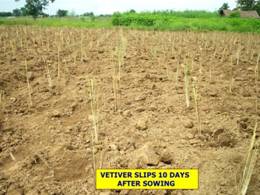
Propagation
Vetiver can be propagated through slips. The top of the slips are cut down before planting to prune transpiration loss, thus giving a better chance for survival of the slips.
The slips are planted in pits, five to eight cm deep made with a pointed stick. One hectare requires 1,50,000 to 2,25,000 slips with 2 - 3 slips per pit in the commonly adopted system of planting (IInd method).
The best planting time to get higher oil yield under South Indian condition is June-July.
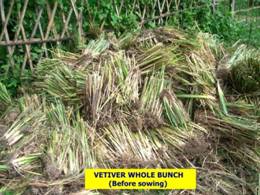 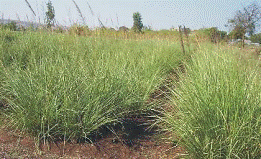
Crop stand
Manures and Fertilizers:
Application of FYM at 10 ton/ha and 60 kg of N, 22.5 kg in each of P2O5 and K2O was found to be efficient in increasing the yield of vetiver.
Intercropping
During the initial crop growth (70-90 days) crops like cowpea, black gram, green gram, cluster bean, pigeon pea, senna and sacred basil can be grown.
Plant protection
No serious insect pests attack this crop. In dry areas termites and white ants attack the roots.
Leaf blight caused by Curvularia trifolii and Fusarium diseases is controlled by repeated spraying and drenching with copper oxychloride or 15 Bordeaux mixture.
Scale insects are kept under check by application of metasystox (0.4%) or chlorpyriphos at 2.5 l/ha.
Harvesting
The plants planted in July should be harvested after 18 months to get the maximum oil yield. Harvesting is usually done during dry season (December to February) by manually digging out the bush along with its roots. The roots are then separated from the leaves, washed and dried under the shade for 1-2 days before distillation.
The roots that possess the following characteristics have good oil content. It should
1. Be slightly reddish brown
2. expose a hard surface when the skin is peeled off
3. be thick, hard, long and wiry and
4. give a very bitter taste when chewed.
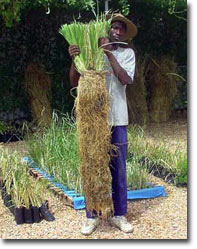
Roots of the vetiver plant after only 6 months cultivation
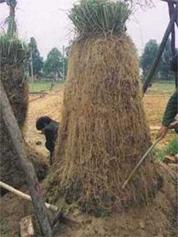
Roots of the two years old vetiver plant
Yield
On an average one hectare of vetiver plantation yields 3-4 tones of roots which on distillation yield 15 to 16 kg of oil. Roots yield 1.00 to 1.50 per cent of oil on dry weight basis.
Source: Aromatic Plants: Vol.01. Horticulture Science Series by Baby P.Skaria
Production technology of Medicinal and Aromatic plants, Kader Mohideen, Arumugam Shakila, Anburani. |





